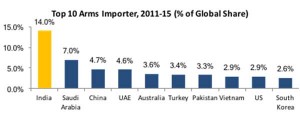India has to address key challenges in the defense procurement sector. India is the 6th largest country in terms of defense spending but is the largest importer of arms in the world, accounting for 14% of the Global Share of Imports between 2011-2015. A key reason is the lack of indigenously designed or manufactured weapons from India.
With the new government coming in a couple of years ago, there were some significant reforms that were proposed for the defense sector. The primary ones which were to make a large and widespread impact were related to liberalizing the foreign direct investment regulations in this sector and the “Make in India” initiative.
However, in the current scenario it is apparent that these reforms have not made any significant impact on arms indigenization in India and there is still lack of a higher degree of buying in India.

Trends in Acquisition under different categories (Rs. in Crores) Source: Dhirendra Singh Committee Report (2015)
Despite the Indian Defense Offset Program, India continues to be the largest importer of arms. While the Offset Program has excited Indian aerospace players, it has had a limited impact on the overall defense sector expenditure. For example, for the Offset Program, the items eligible for offset discharge are placed under 4 categories, one of which is ITC HS Code 88 (accounted for 85% of the exports in 2015) but these are primarily related to components of civilian aircrafts.
Additional challenges that come up are dependence on foreign players and countries, and foreign currency use. Alongside that, it is a worrying situation when, despite the large scale imports India is not getting recognized as a formidable purchaser and getting the benefits of large scale deals. Could the reason for that be our dispersed and not focused purchasing policy?
What is now clear is that there are many reasons for limited impact of this program and hence to ensure that the results that were envisioned for this sector are achieved, new reforms that need to be started, are being proposed and are being implemented.
A couple of such announcement and actions taken up in May are as follows:
• Strategic Partnership Policy for manufacturing in India – This entails giving the defense private sector players a bigger role in all aspects of design, development, as applicable for production of major platforms and weapon systems. The overall framework of this model has four broad categories – combat aircraft, helicopters, submarines and armored vehicles. The government will award programs within each of these to the private sector.
The Strategic Partnership Policy has addressed concerns of both the private and public sectors. It has allowed one organization to pursue opportunities on multiple platforms and for the public sector it will allow DPSU’s to also participate in the future. All the three defense arms of the country have now indicated their willingness to apply for “Acceptance of Necessity” and expect that we would have a defined way forward in 6-9 months.
• Defense Procurement Organization – This is a proposal which involves creation of an independent entity that functions without government intervention, on the core function of defense procurement. The reason for the same is the lack of cohesiveness and synergy, between multiple government departments which has resulted in delays and financial cost implications. The role of this organization will be to approach each acquisition from a project management mindset. This will likely also channel India’s clout as a global purchaser and give us resultant benefits.
Steps such as the above will help India in the following:
• Creation of a vibrant private sector defense eco-system rather than just outsourced suppliers – This is the first step to help the reforms in getting implemented. Also, in order to make it objective and fair, there are suggestions on the bidding process to be followed for the private sector. The Indian bidders will also need to be empowered to select their overseas OEMs. For that aspect, the approach being suggested is that the Government will select them (the overseas OEMs) and from this list of shortlisted foreign OEMs, the Indian companies will need to connect to discuss the next level of partnership.
• Increased pace of modernization of our armed forces – With the boost to the private sector’s role in defense production, the pace of modernization and accessibility to international standard defense equipment for our armed forces will become a reality. The quality expertise, technical know-how and professionalism of the private sector will percolate into the key area of defense manufacturing, which has in the past been hindered in terms of its progress, mainly due to these aspects.
• Getting a bigger bang for our import bills – The DPO or Defense Procurement Organization will help us achieve what we want to in terms of gaining from our large-scale imports of arms, by streamlining the mega arms acquisitions.
• Saving of foreign currency – The resultant or spill over effect from the previous advantage is that India will save foreign currency.
Ensuring that these reforms continue to proceed is the only way to create a sustainable defense set-up in India, which is also self-reliant. The positive implications of such a structure are immense and it is only by focusing on the reforms that these benefits can be realized, in India.






